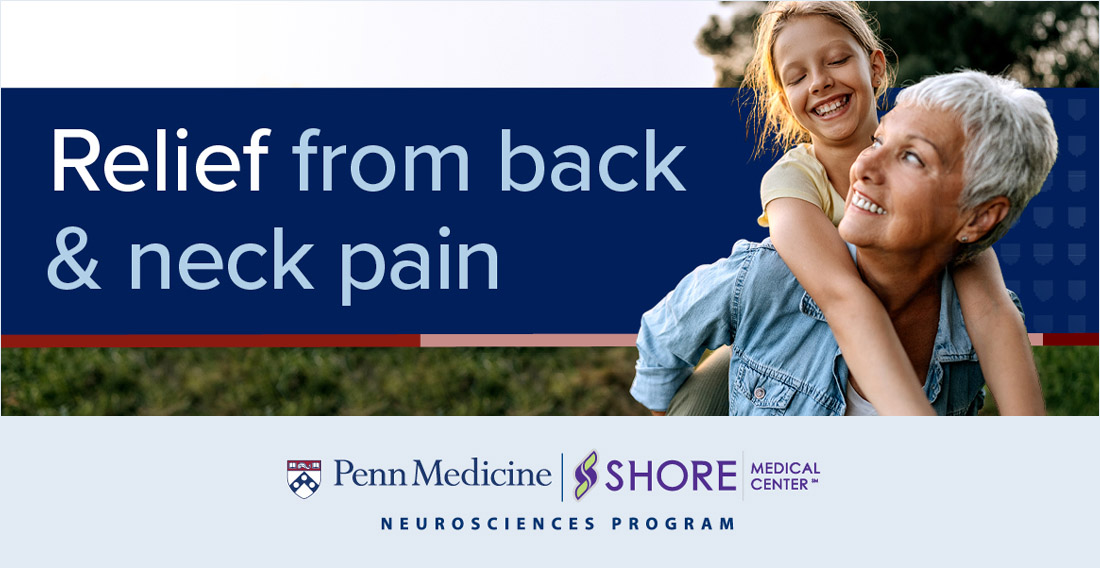At Shore Medical Center, we are proud to offer a comprehensive Neuroscience Program in affiliation with Penn Medicine, delivering expert care conveniently located in Somers Point.
Whether patients are managing complex neurological conditions or recovering from spine or brain surgery, our on-site specialists provide advanced, compassionate care supported by state-of-the-art technology and evidence-based protocols.
- Advanced Neurosurgical Care in Collaboration with Penn Medicine
Penn Medicine | Shore Medical Center Neurosciences Program offers surgical solutions for both common and complex neurological disorders. Our highly trained team employs advanced surgical techniques and image-guided technologies to optimize precision and improve outcomes. A key focus is on minimally invasive procedures, which typically result in smaller incisions, shorter operative times, reduced hospital stays, and faster recovery.
Shore Physicians Group's Francis Kralick, D.O., F.A.C.O.S., is the Division Chief of Neurosurgery at Shore Medical Center and a member of the Penn Specialty Network. Our team of highly skilled, fellowship-trained neurosurgical experts also includes Michael Spadola, MD, a Penn Medicine Neurosurgeon specializing in advanced spinal procedures.
Together, they represent the forefront of Shore’s commitment to providing exceptional neurosurgical care and delivering the best possible outcomes for our patients. For an appointment with Dr. Kralick or Dr. Spadola, call 609.365.6239.
- Expert Spine Surgery in Somers Point
Shore’s Neurosurgery Program offers a full spectrum of spine procedures, including:
- Anterior Cervical Discectomy with Fusion (ACDF) – Removes a damaged disc in the neck and stabilizes the spine
- Cervical Disc Replacement – Maintains natural motion by replacing the damaged disc
- Complex Revision Spine Surgery – Corrects or improves outcomes from prior spinal surgeries
- Laminectomy – Alleviates pressure on the spinal cord or nerves by removing part of the vertebra
- Neurostimulator Placement and Revision – Manages chronic pain through spinal cord stimulation technology
- Spinal Fusion Surgery – Stabilizes spinal segments using several approaches:
- Anterior Lumbar Interbody Fusion (ALIF)
- Posterior Lumbar Interbody Fusion (PLIF)
- Lateral Transpsoas Interbody Fusion (XLIF)
- Transforaminal Lumbar Interbody Fusion (TLIF)
- Thoracic Discectomy – Removes herniated discs in the thoracic spine
- Surgical Services
To learn more about Shore’s surgical services, including patient education for pre- and post-operative care, robotic-assisted surgery, and pain management, visit our Surgical Services page.
- Stroke Program
Just as your brain and spine are command central for your entire body, Shore's Stroke Program is the region's command central for treating disorders of the brain, spine, peripheral nerves and muscles. Learn More >
- Comprehensive Neurology Services
As an essential component of the Neuroscience Program, our Neurology Division brings together a team of board-certified neurologists with extensive experience treating a broad spectrum of neurological conditions. These include epilepsy, stroke, multiple sclerosis, Alzheimer’s disease, dementia, Parkinson’s disease, traumatic brain injury, ALS, Huntington disease, Tourette syndrome, Mitcochondrial disorders, and more. We also offer advanced diagnostic and therapeutic services such as electromyography (EMG) to evaluate nerve and muscle health, and neurotoxin treatments for muscle spasticity and chronic migraines.
Shore Physicians Group's neurology team is led by Ralf Van der Sluis, MD, Division Chief of Neurology. Dr. Van der Sluis and his colleagues provide expert neurological care both within the hospital and in outpatient settings, offering patients the personalized, compassionate attention they need every step of the way.








